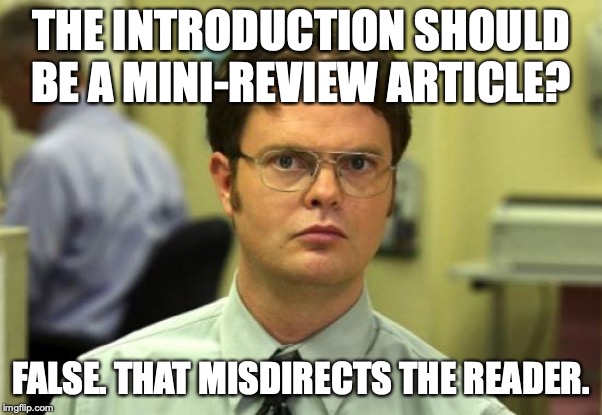I often tell my students that the Introduction is the most important part of a scientific paper, in terms of setting up the rest of the paper to make it easy to write, and in terms of making it easy for the readers to be able to follow the rest of the paper. If the readers get confused, bored, or annoyed they will stop reading, and probably won’t cite your paper. And they will get confused, bored, or annoyed if they don’t know what to expect, or if their expectations are not being met. So, here is your big chance to help your readers enjoy reading your paper. In this post, I will describe three of the biggest mistakes I see happening over and over in scientific papers.
Mistake 1: It contains a literature review
But Brian, you might be saying, isn’t the Introduction just a literature review? Why are you telling me there shouldn’t be a literature review? I’m telling you this because you should be writing the background to your research question, not reviewing the literature.
When I began writing scientific papers, I thought that the Introduction was a miniature review article. So that is what I wrote. Reviewing the literature means going over basically everything that is known about a given topic, within the scope of your paper. When you do that, you will inevitably include information that is relevant to the broader topic, but that is NOT relevant to your specific, narrow research question.

This information should be left out. Why? Because, when you tell information to your readers, they assume that it is relevant, and that it is important to know for what is coming later. Then they will expect that some of your experiments or results will relate to that information, and they will be looking and waiting for it. Then, when it never comes, they become confused or irritated, because their expectations have not been fulfilled. By reviewing the literature, you unintentionally misdirect the readers, and set up false expectations that you will not fulfill. So, instead of writing a literature review, you need to give ONLY the background that is needed to accomplish what is coming next, establishing knowledge gaps.
Mistake 2: The knowledge gaps are missing
Another problem with writing a literature review for you Introduction is that it is not readily conducive to pointing out knowledge gaps. But, you absolutely must point out knowledge gaps to have a successful Introduction section. After all, the whole point of science is to generate new knowledge. It is hard to do that if your experiments or studies are not designed to address and fill knowledge gaps. Even discovery studies need to address knowledge gaps. So, the point of giving background material, that is, discussing previously published papers, is to establish what is currently known for the purpose of contrasting that knowledge with what we don’t know, but need to determine to advance science. Clearly stating the knowledge gaps is key to helping the reader understand why your study is important and why it will be significant. Many times, they are completely missing, or are stated in an indirect or obtuse way that are not very helpful to the readers. Clearly stating the knowledge gaps will lead directly to the next rhetorical move we will discuss; setting up the research question.
Mistake 3: The research question is missing
The research question or purpose (whichever is more appropriate) of the study, is the heart of your paper. The Introduction needs to funnel to it, and the remainder of the paper needs to refer back to it. The research question or purpose forms the basis of what experiments you will do, or what data you will collect (your specific objectives). Yet, the research question or purpose is so often missing or obscured. Logically, it should follow the knowledge gaps, and lead to the objectives of the study. The research question or purpose will be the subtext for the Results, and the focal point of the Discussion.

So why is it so often missing, or obscured? The best answer I have is that graduate students don’t get enough explicit training when they are learning to write scientific papers, and they don’t know how to set them up properly. Alternatively, they have been taught that all scientific papers must have a hypothesis, and they force their logical Introduction structure into something leading to a hypothesis, even when it doesn’t make sense. But that’s a post for another time.
Do you notice any other common problems with the Introduction? Leave a comment below!

I am sure that all these contents will be of great help to our graduate students in my lab to write their papers.